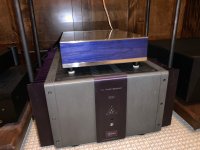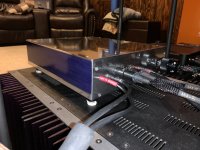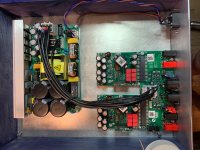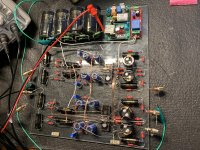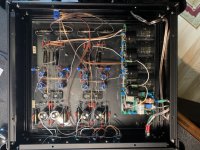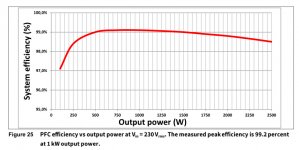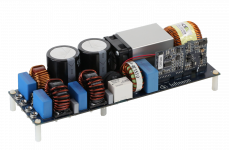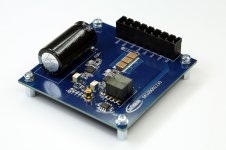This thread is for discussing what we need for builds of amps based on the Purifi 1ET400A module.
Some discussion topics, but we are not limited to these:
Some discussion topics, but we are not limited to these:
- We can start with the EVAL1 kit and a Hypex SMPS1200A400 power supply.
- What do need to do if we want to use alternative buffers (could Tom Christiansen's universal buffer be adapted? how would an adapter board look like? Could we lobby him to provide one? Could we lobby Apollon to provide their buffer boards?)
- Alternative power supplies. It seems that the Purifi boards need an independent drive gate supply. Can we still use a Connex SMPS?
- Finally, possible BOMs.
Jumping in. I considered doing an M22 clone, but seeing that the 1ET400A is probably a better option in 2019/20, I might as well move forward.
I might be interested in Neurochrome Universal Buffer. Wouldn't an adapter card be fairly simple to design - it is a passive component. Alternatively, one could use wires and p2p.
Universal Buffer – Neurochrome
I might be interested in Neurochrome Universal Buffer. Wouldn't an adapter card be fairly simple to design - it is a passive component. Alternatively, one could use wires and p2p.
Universal Buffer – Neurochrome
An externally hosted image should be here but it was not working when we last tested it.
Last edited:
There are two potential problems in a non-Purifi-sourced adapter board (neither of which is beyond Tom's capabilities). First, the Purifi 1ET400A has 12.8dB of gain. This is enough for me, but just about everyone else here seems to like more than that. The other problem is due on the fact that the 1ET400A has only one connector which has pins for power (high voltage +/- and +/-15V or so), ground, input, output and a bunch of pins for control and status. That would mean any adapter board would need to handle all of this. As the pinout for this module is not published, this is assuming it's the same as the Hypex NC500 OEM (based on your post from the other 1ET400A thread). Check the documentation for the NC500 OEM - which of these pins would you want exposed as a DIYer?
It certainly looks like NC400/500 and 1ET400A has similar pin out which would make them compatible which would answer the question; Can 1ET400A be a drop in replacement in NAD M22.
The other part, I am sure Tom would investigate it so that all issues are taken care of. Why not send Tom an email addressing your concerns ??
The other part, I am sure Tom would investigate it so that all issues are taken care of. Why not send Tom an email addressing your concerns ??
Regarding the pinout issue and buffers - I am an idiot. We can initially get the full EVAL1 kit, bypass the on board buffer (the jumpers do not modify the buffer gain to unity, they bypass the buffer completely) and connect the desired non-Purifi buffer to the XLR input. In fact, we could even desolder the XLR connectors and connect the wires directly. LOL.
Some waste of circuitry? True, but the Purifi board lacks feedback capacitors to limit the amp bandwidth and input filtering, as Alan of March audio pointed out. A buffer properly designed for general use would have those (the Purifi board, like the NC500 evaluation boards, is properly designed for OEMs including boutique manufacturers to get started).
Note that the Purifi evaluation input board has the control logic that one needs to get the modules working. In fact, one gets a fully functioning amplifier with those (with the above caveats). This logic is still there when we bypass the buffer. This means also that it would not be "wasted" ;-)
So, for the moment this is a non issue. There is not even need to annoy Tom Christiansen that is now on vacation and will return to deliver the universal buffer, so I am quite confident he has no time at the moment to work on a board.
Some waste of circuitry? True, but the Purifi board lacks feedback capacitors to limit the amp bandwidth and input filtering, as Alan of March audio pointed out. A buffer properly designed for general use would have those (the Purifi board, like the NC500 evaluation boards, is properly designed for OEMs including boutique manufacturers to get started).
Note that the Purifi evaluation input board has the control logic that one needs to get the modules working. In fact, one gets a fully functioning amplifier with those (with the above caveats). This logic is still there when we bypass the buffer. This means also that it would not be "wasted" ;-)
So, for the moment this is a non issue. There is not even need to annoy Tom Christiansen that is now on vacation and will return to deliver the universal buffer, so I am quite confident he has no time at the moment to work on a board.
Last edited:
So.. modify the EVAL1 so that buffer stage goes through Tom's buffer stage, I see. I could live with that.
There is not really much to modify, the buffer stage is bypassed by a jumper setting. This is part of the EVAL1 design, so it turns just into a few extra CM of signal on PCB tracks, I do not think this is a disaster. If you do not want to remove the xlr just stick the cables in the XLR contact holes (maybe just crimp suitable pins on the cables ;-)
GaN SMPS +99% Efficiency
Taken from post over at Hypex NCore NC500 build post #1980
I did some further investigations and found that Infineon has an interesting GaN SPMS.
EVAL_2500W_PFC_GAN_A
Sources:
EVAL_2500W_PFC_GAN_A - Infineon Technologies
EVAL_1EDF_G1_HB_GAN - Infineon Technologies
Taken from post over at Hypex NCore NC500 build post #1980
I did some further investigations and found that Infineon has an interesting GaN SPMS.
EVAL_2500W_PFC_GAN_A
EVAL_1EDF_G1_HB_GAN - Halfbridge (DC-DC)2500W full-bridge totem-pole power factor correction evaluation board using CoolGaN™ 600V e-mode HEMT
This 2.5kW CCM full-bridge PFC evaluation board utilizes the advantages of Infineon’s CoolGaN™ technology to boost system efficiency above 99 percent for efficiency-critical applications such as server power supplies or telecom rectifiers. The board features CoolGaN™ 600V e-mode HEMTs, CoolMOS™ C7 Gold superjunction MOSFET and EiceDRIVER™ gate driver ICs.
Flat efficiency >99 percent over wide load range
Hypex SMPS1200A400 is 92% efficient in comparison.CoolGaN™ 600V e-mode HEMT half-bridge evaluation platform featuring GaN EiceDRIVER™
This 600V gallium nitride (GaN) half-bridge evaluation board enables easy, rapid setup and test of CoolGaN™ transistors. The generic topology can be configured for boost or buck operation, pulse testing or continuous full-power operation. Test points provide easy access to connect signals to an oscilloscope, to measure the switching performance of CoolGaN™ transistors and gate driver. This board saves the user from having to design their own gate driver and power circuit to evaluate gallium nitride transistors.
Sources:
EVAL_2500W_PFC_GAN_A - Infineon Technologies
EVAL_1EDF_G1_HB_GAN - Infineon Technologies
Attachments
Care to do a block diagram or picture guide ? Stuff like that is usefulThere is not really much to modify, the buffer stage is bypassed by a jumper setting. This is part of the EVAL1 design, so it turns just into a few extra CM of signal on PCB tracks, I do not think this is a disaster. If you do not want to remove the xlr just stick the cables in the XLR contact holes (maybe just crimp suitable pins on the cables ;-)
Care to do a block diagram or picture guide ? Stuff like that is useful
I still do not know whether one can omit to connect some of the supplies in case the buffers on the EVAL1 are bypassed.
Roberto
Since I'm a bit behind when it comes to fully understanding circuits, isn't Neurochrome's buffer the driver / control circuit ? plus the 65vdc supply ?I still do not know whether one can omit to connect some of the supplies in case the buffers on the EVAL1 are bypassed.
Roberto
Since I'm a bit behind when it comes to fully understanding circuits, isn't Neurochrome's buffer the driver / control circuit ? plus the 65vdc supply ?
No, the neurochrome universal buffer is a pure buffer
Universal Buffer – Neurochrome
It does not know how to control a Purifi board - in fact it has no control circuitry at all.
It would replace the buffer in the EVAL1 board, that lacks bandwidth limiting and global feedback to ensure its stability (hence, the EVAL1 buffers are bypassed).
The neurochrome board needs its separate regulated supply.
Roberto
Last edited:
I am trying to figure out via the user guide which section is the buffer, so question is if its bypassed by:
And the Neurochrome buffer could use the Salas SSLV1.3 UltraBiB shunt regulator as the PSU5.2 HW Mode (page 8)
The amplifier modules are controlled via toggle switch S1 connected to amplifier control signal /AMPON./AMPON is also made available on connectors J3 and can be controlled via external source once shunt R3 has been removed.
3.4 Aux connector, J3
Pin5: +VUNREG P Voltage regulator input, positive rail
Pin: 6 GND - Ground
Pin: 7 -VUNREG P Voltage regulator input, negative rail
- Home
- Amplifiers
- Class D
- Brainstorming Purifi 1et400a amps
